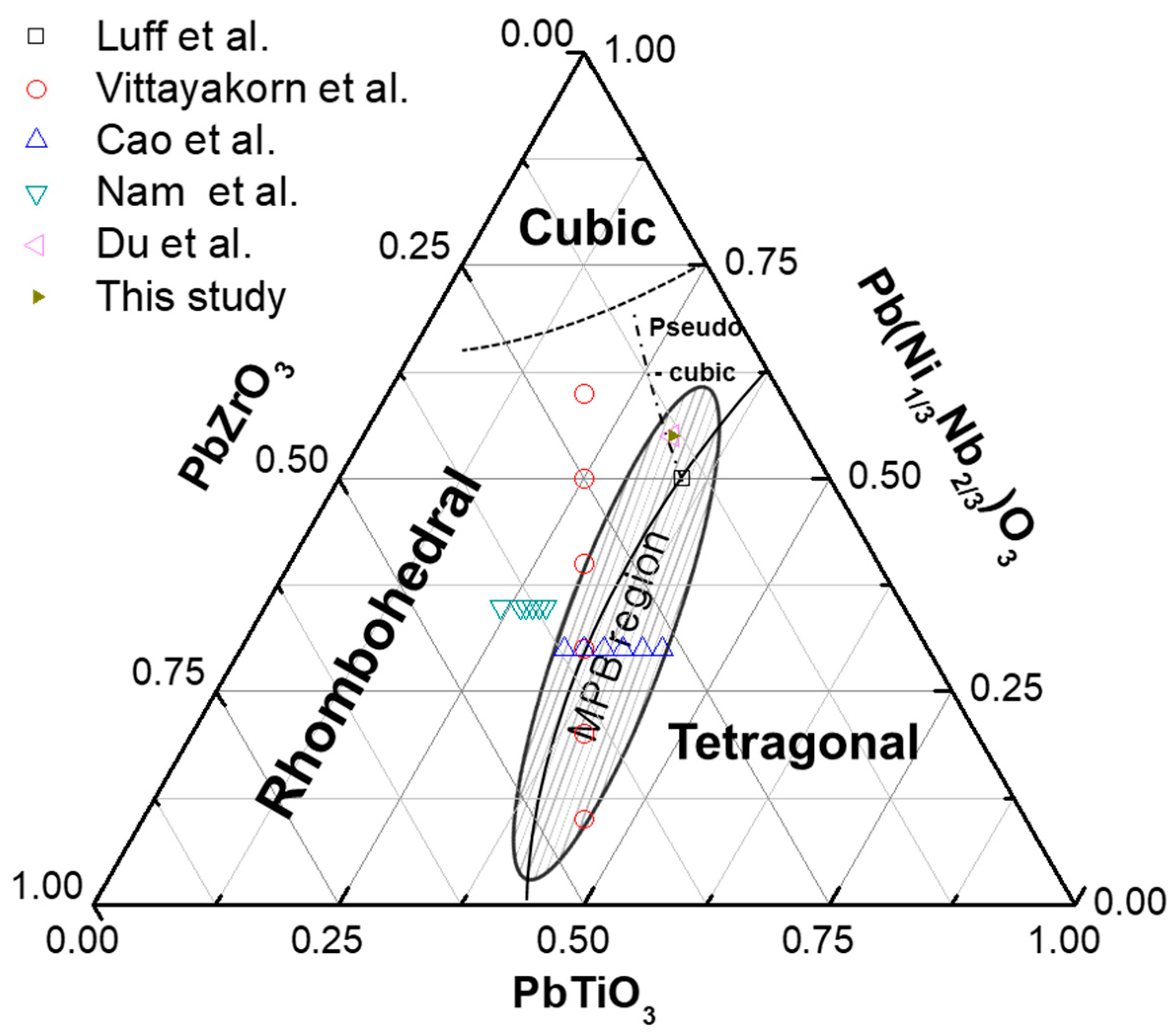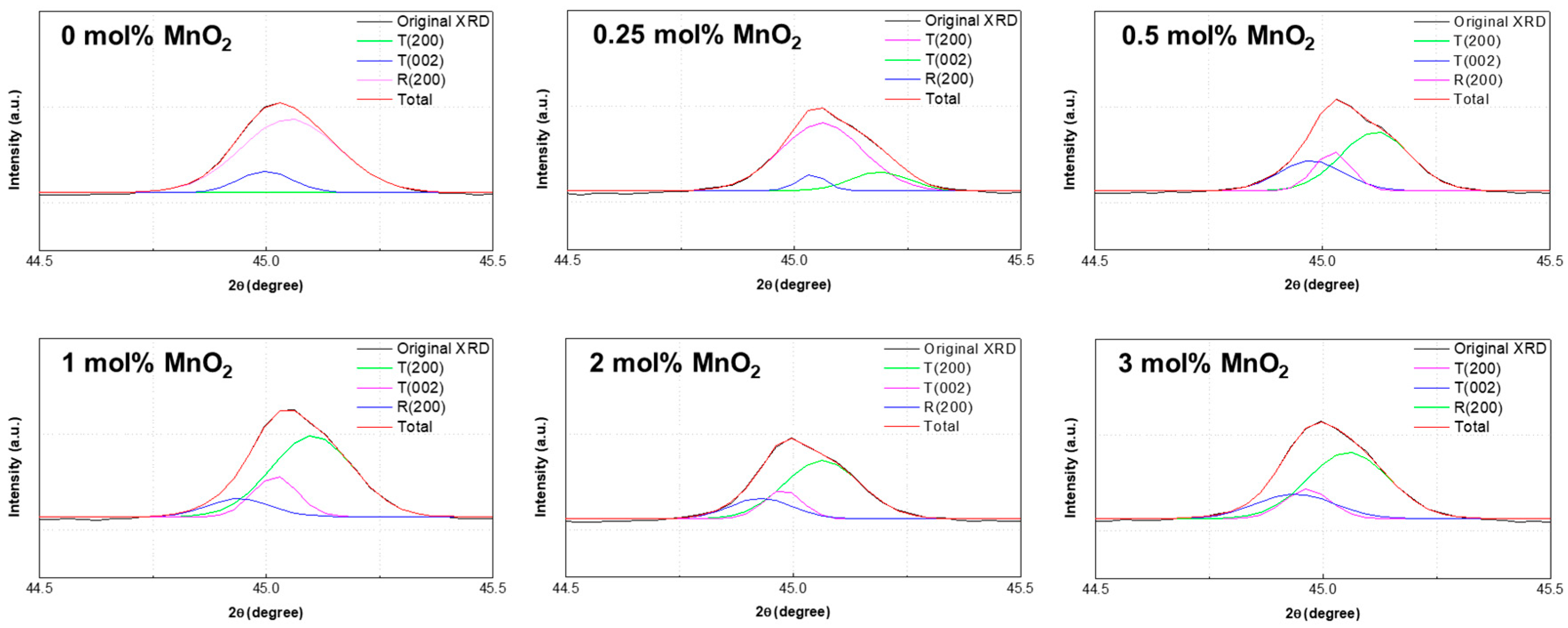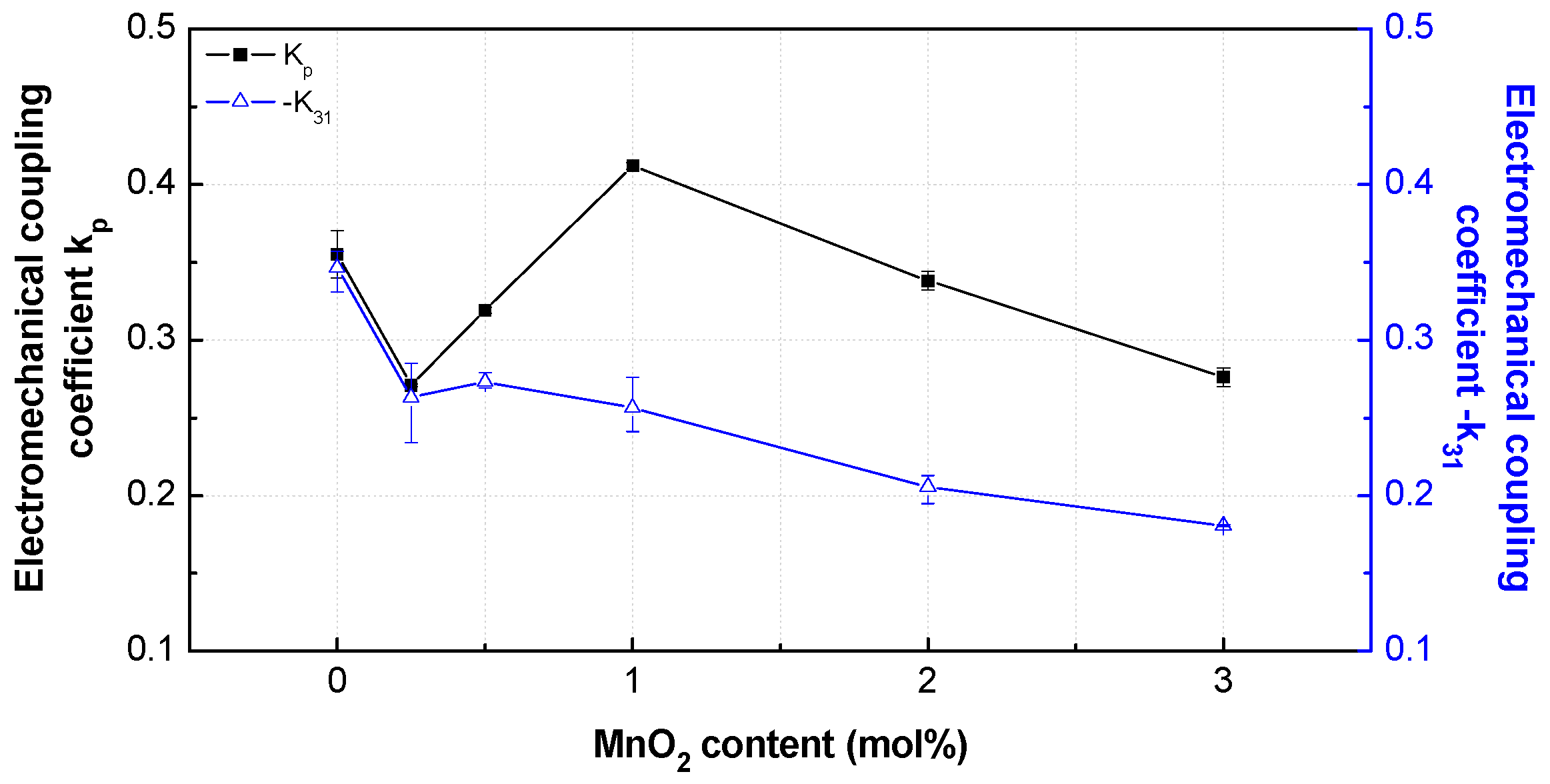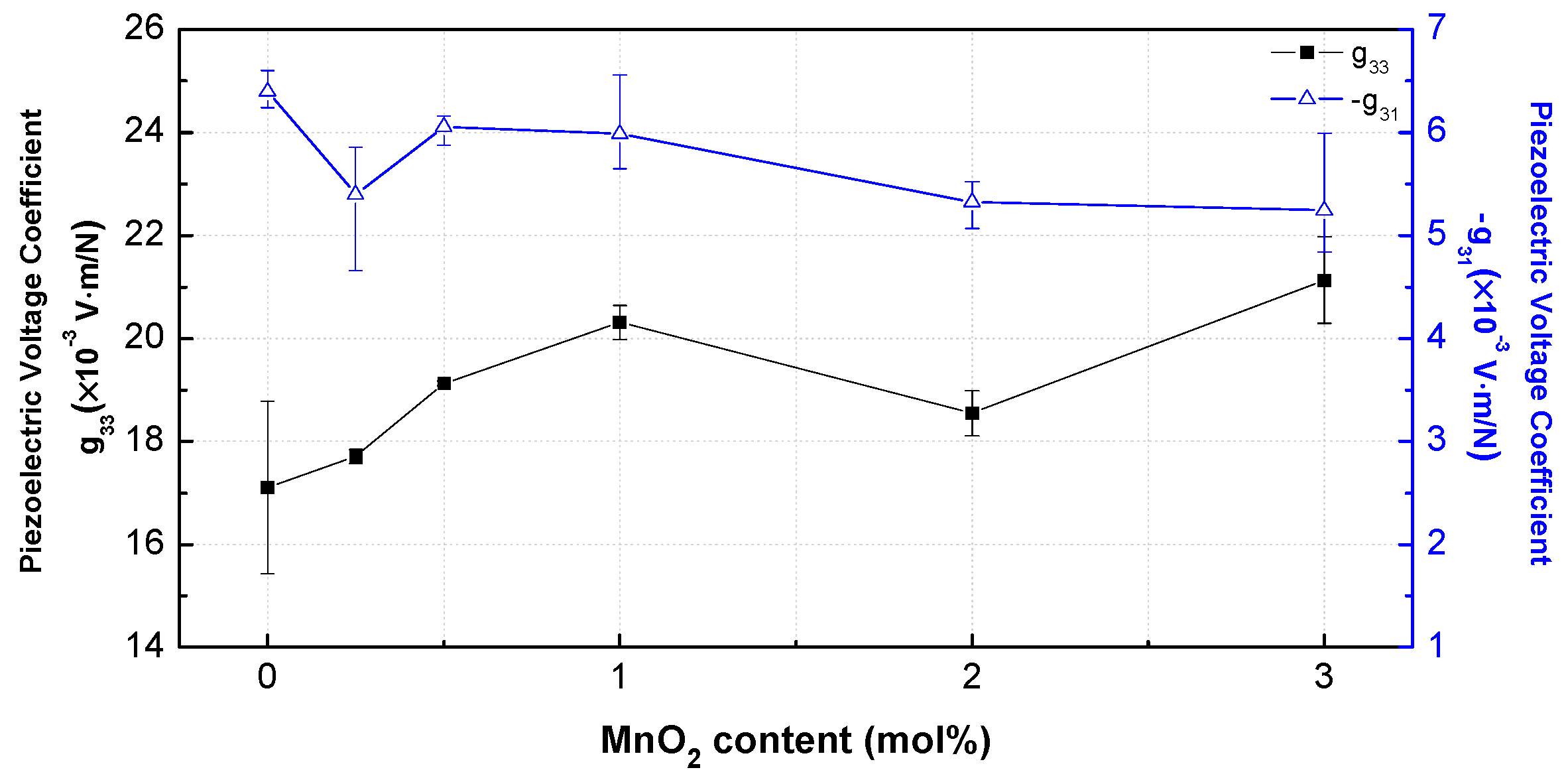Piezoelectric Characteristics of 0.55Pb(Ni1/3Nb2/3)O3-0.45Pb(Zr,Ti)O3 Ceramics with Different MnO2 Concentrations for Ultrasound Transducer Applications
Abstract
:1. Introduction
2. Synthesis of the MnO2-Doped PNN-PZT
3. Results and Discussion
3.1. Phase and Microstructure
3.2. Dielectric Properties
3.3. Mechanical Properties
3.4. Piezoelectric Properties
4. Conclusions
Author Contributions
Funding
Conflicts of Interest
References
- Mahajan, S.; Thakur, O.P.; Prakash, C. Effect of Sintering Temperature on Structural and Piezoelectric Properties of PNN-PZT Ceramics. Def. Sci. J. 2007, 57, 23–28. [Google Scholar] [CrossRef] [Green Version]
- Gouadec, G.; Colomban, P.; Slodczyk, A.; Pham-Thi, M. Stress and temperature driven phase transitions in single crystalline KNbO3 and textured KNL-NTS ceramics: A Raman andthermal expansion study. In Proceedings of the 2014 Joint IEEE International Symposium on the Applications of Ferroelectric, International Workshop on Acoustic Transduction Materials and Devices & Workshop on Piezoresponse Force Microscopy, State College, PA, USA, 12–16 May 2014; pp. 1–4. [Google Scholar]
- Du, J.; Qiu, J.; Zhu, K.; Ji, H. Enhanced piezoelectric properties of 0.55Pb(Ni1/3Nb2/3)O3-0.135PbZrO3-0.315PbTiO3 ternary ceramics by optimizing sintering temperature. J. Electroceramics 2014, 32, 234–239. [Google Scholar] [CrossRef]
- Liu, H.; Nie, R.; Yue, Y.; Zhang, Q.; Chen, Q.; Zhu, J.; Yu, P.; Xiao, D.; Wang, C.; Wang, X. Effect of MnO2 doping on piezoelectric, dielectric and ferroelectric properties of PNN–PZT ceramics. Ceram. Int. 2015, 41, 11359–11364. [Google Scholar] [CrossRef]
- Luff, D.; Lane, R.; Brown, K.R.; Marshallsay, H.J. Piezoelectric properties of 0.5Pb(Ni1/3Nb2/3)O3-0.35PbTiO3-0.15PbZrO3 ceramics. Trans. J. Br. Ceram. Soc. 1974, 73, 251. [Google Scholar]
- Vittayakorn, N.; Rujijanagul, G.; Tan, X.; Marquardt, M.A.; Cann, D.P. The morphotropic phase boundary and dielectric properties of the xPb(Zr1/2Ti1/2)O3-(1 − x)Pb(Ni1/3Nb2/3)O3 perovskite solid solution. J. Appl. Phys. 2004, 96, 5103–5109. [Google Scholar] [CrossRef]
- Cao, R.; Li, G.; Zeng, J.; Zhao, S.; Zheng, L.; Yin, Q. The piezoelectric and dielectric properties of 0.3Pb (Ni1/3Nb2/3)O3-xPbTiO3-(0.7 − x)PbZrO3 ferroelectric ceramics near the morphotropic phase boundary. J. Am. Ceram. Soc. 2010, 93, 737–741. [Google Scholar] [CrossRef]
- Nam, C.H.; Park, H.Y.; Seo, I.T.; Choi, J.H.; Joung, M.R.; Nahm, S.; Lee, H.J.; Kim, Y.H.; Sung, T.H. Low-Temperature Sintering and Piezoelectric Properties of 0.65Pb(Zr1 − xTix)O3-0.35Pb(Ni0.33Nb0.67)O3 Ceramics. J. Am. Ceram. Soc. 2011, 94, 3442–3448. [Google Scholar] [CrossRef]
- Yu, C.S.; Hsieh, H.L. Piezoelectric properties of Pb(Ni1/3,Sb2/3)O3-PbTiO3-PbZrO3 ceramics modified with MnO2 additive. J. Eur. Ceram. Soc. 2005, 25, 2425–2427. [Google Scholar] [CrossRef]
- Bamière, F.; Benkert, K.; Radanielina, M.; Schuh, C.; Hoffmann, M.J. Low temperature sintering and high piezoelectric properties of strontium doped PNZT–PNN ceramics processed via the columbite route. J. Eur. Ceram. Soc. 2007, 27, 3613–3617. [Google Scholar] [CrossRef]
- Du, J.; Qiu, J.; Zhu, K.; Ji, H.; Pang, X.; Luo, J. Effects of Fe2O3 doping on the microstructure and piezoelectric properties of 0.55Pb(Ni1/3Nb2/3)O3-0.45Pb(Zr0.3Ti0.7)O3 ceramics. Mater. Lett. 2012, 66, 153–155. [Google Scholar] [CrossRef]
- Yoo, J.; Lee, S. Piezoelectric properties of MnO2 doped low temperature sintering Pb(Mn1/3Nb2/3)O3-Pb(Ni1/3Nb2/3)O3-Pb(Zr0.50Ti0.50)O3 ceramics. J. Electroceramics 2009, 23, 432. [Google Scholar] [CrossRef]
- Liao, Q.; Chen, X.; Chu, X.; Zeng, F.; Guo, D. Effect of Fe doping on the structure and electric properties of relaxor type BSPT-PZN piezoelectric ceramics near the morphotropic phase boundary. Sens. Actuators A Phys. 2013, 201, 222–229. [Google Scholar] [CrossRef] [Green Version]
- Kang, S.H.; Kang, M.; Kang, L.H. Piezoelectric smart composite blades for collision monitoring: Measurement of mechanical properties and impact sensitivity. Composit. Struct. 2018, 202, 1295–1307. [Google Scholar]










| Authors | Piezoelectric Ceramic | Doping | Properties |
|---|---|---|---|
| Yu et al. [9] | 0.12Pb(Ni1/3Sb2/3)-0.48PbTiO3-0.40PbZrO3 | 0.15 wt% MnO2 | Kp = 0.68, εr = 3069, Qm = 181, tanδ = 5.4 × 10−3 |
| Bamiere et al. [10] | 0.674Pb,Nd(Zr, Ti)O3-Pb(Ni1/3Nb2/3)O3 | SrCO3 (0~4 mol%) | Lower the sintering temperature |
| Du et al. [11] | 0.55Pb(Ni1/3Nb2/3)O3-0.45Pb(Zr0.3Ti0.7)O3 | Fe2O3 (0~1.6 mol%) | ρ = 7.97 g/cm3, d33 = 956 pC/N, Kp = 0.74, εr = 6095, tanδ = 26 × 10−3 |
| Yoo et al. [12] | 0.02Pb(Mn1/3Nb2/3)O3-0.12Pb(Ni1/3Nb2/3)O3-0.86Pb(Zr0.5Ti0.5)O3 | 0.2 wt% MnO2 | ρ = 7.816 g/cm3, d33 = 356 pC/N, kp = 0.597, εr = 920, Qm = 1186 |
| Liao et al. [13] | 0.35BiScO3-0.6PbTiO3-0.05Pb(Zn1/3Nb2/3)O3 | Fe2O3 (0~1.6 mol%) | Largely reduced tanδ and d33, but improved Qm |
| Liu et al. [4] | 0.55Pb(Ni1/3Nb2/3)O3-0.45Pb(Zr0.3Ti0.7)O3 | 1 mol% MnO2 | d33 = 710 pC/N, kp = 0.595, εr = 3092.25, tanδ = 14.9 × 10−3, Qm = 176 |
| MnO2 Content | Density (kg/m3) | εr at 1 kHz | tanδ (%) at 1 kHz | Qm | YE11 (× 1010 N/m2) | K31 | kp | −d31 (pC/N) | d33 (pC/N) | −g31 (× 10−3 V∙m/N) | g33 (× 10−3 V∙m/N) |
|---|---|---|---|---|---|---|---|---|---|---|---|
| 0 mol% | 7771.09 | 4925.51 | 5.6 | 42.70 | 7.14 | 0.35 | 0.36 | 243.40 | 746 | 6.40 | 17.10 |
| 0.25 mol% | 7782.96 | 3772.38 | 2.85 | 50.99 | 7.70 | 0.26 | 0.27 | 167.07 | 592 | 5.40 | 17.71 |
| 0.5 mol% | 7864.18 | 3177.74 | 1.6 | 63.49 | 8.70 | 0.27 | 0.32 | 140.40 | 538 | 6.06 | 19.13 |
| 1 mol% | 7936.33 | 2965.10 | 1.6 | 139.70 | 9.56 | 0.26 | 0.41 | 115.01 | 533 | 5.99 | 20.31 |
| 2 mol% | 7938.13 | 2408.93 | 2.4 | 173.50 | 10.11 | 0.21 | 0.34 | 78.51 | 396 | 5.33 | 18.55 |
| 3 mol% | 7938.41 | 1826.92 | 4.5 | 202.26 | 10.56 | 0.18 | 0.28 | 68.98 | 342 | 5.24 | 21.13 |
© 2019 by the authors. Licensee MDPI, Basel, Switzerland. This article is an open access article distributed under the terms and conditions of the Creative Commons Attribution (CC BY) license (http://creativecommons.org/licenses/by/4.0/).
Share and Cite
Kang, M.; Kang, L.-H. Piezoelectric Characteristics of 0.55Pb(Ni1/3Nb2/3)O3-0.45Pb(Zr,Ti)O3 Ceramics with Different MnO2 Concentrations for Ultrasound Transducer Applications. Materials 2019, 12, 4115. https://doi.org/10.3390/ma12244115
Kang M, Kang L-H. Piezoelectric Characteristics of 0.55Pb(Ni1/3Nb2/3)O3-0.45Pb(Zr,Ti)O3 Ceramics with Different MnO2 Concentrations for Ultrasound Transducer Applications. Materials. 2019; 12(24):4115. https://doi.org/10.3390/ma12244115
Chicago/Turabian StyleKang, Myeongcheol, and Lae-Hyong Kang. 2019. "Piezoelectric Characteristics of 0.55Pb(Ni1/3Nb2/3)O3-0.45Pb(Zr,Ti)O3 Ceramics with Different MnO2 Concentrations for Ultrasound Transducer Applications" Materials 12, no. 24: 4115. https://doi.org/10.3390/ma12244115





